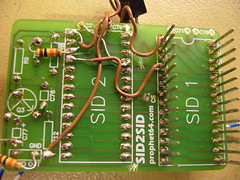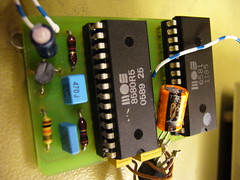SID2SID with two different SID flavours: Finished
November 22nd, 2007I finally inished my special SID2SID, which has a little hack that allows you to use two different flavours of SID on the same board, at least if used on a 6581 board. The trick is to regulate the 12V used for the 6581 down to 9V, for the 8580. The 8580 should use the same filter caps as 8580 always uses. I don’t remember the value, but the SID2SID manual covers this.
Here’s my test setup:
Prophet64 still identifies the main SID, a 6581. On the right, the audio outpus from the SIDs.
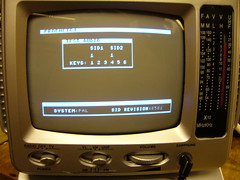
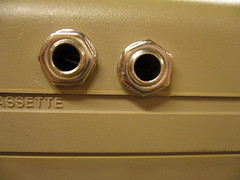
And here is a closer look of the little beauty. It’s too much of a snake’s nest, but that was because of a mistake of mine. The left picture is the bottom side of the SID2SID. It’s filled with dirty tricks. The first thing I want to point out is the voltage regulator. It has three wires. For the voltage regulator to have any effect at all, you have to cut the trace to VDD and connect the voltage regulator. (If you don’t know, or can’t find instructions, how to connect a voltage regulator, you probably shouldn’t do this mod, so I won’t tell you the exact wiring.)
I first cut the wrong trace, so there’s one excess wire to fix that.
The regulator should be a 7809, (+9 V regulator) but all I could find was a 7808. (+8 V regulator) That’s 1 V too low, but works, and will hopefully help keep the chip cool. The big cap attached to it was an attempt to keep noise in VDD to a minimum, but didn’t help much. However, it fits perfectly between the IC sockets and keeps the regulator steady in one place.
The resistor on the upper left grounds the SID sound input, which reduces the noise a little. The resistor on the lower left charges DC blocking cap, so that it’s nicely charged when you plug it into something. Hopefully this will help protect the chip, but maybe it will make it burn out faster. Time will tell.
No sounds samples up yet sorry, but it works fine. What doesn’t work fine is joystick port 2, where the fire button seems to be fried from ESD. (I finally realized this) So unless I learn how to use P64 without a mouse, no fun for some time. (But I can still use drummer and bassline of course.)
In the long run, I’d like to implement one or more of AlphA’s C64 mods. I will also try to modify the filter circuit in a strange way, bend if you will. Any news, and you’ll hear it here.
Also, fuckings to ps.
Update: Answer to Joey’s question:
In order to do what you want to you have drop the voltage and replace the caps, yes. The easiest way to replace the caps for SID 1 is to cut the 4 filter legs of the board, and solder 8580 compatible capacitors on the SID2SID board. The SID2SID cover this topic well.
As for regulating the voltage, I advise you to cut off the VDD pin, or possible bend it upwards in some acrobatic manner. That’s where the higher voltage goes onto the SID2SID board, somehow making sure that pin is not directly connect to the 12 V source on the board is crucial if you don’t want to fry two chips in one go. (*Shudders*)
Then you can connect the output of the regulator to that pin you’ve just bent/cut. Ground goes to ground and input goes to input. Crazy as I am, in your situation I would’ve tried to somehow fit the regulator where the VDD pin was. This way you can just put down the chip in the socket and the regulator leg would go in the right place. But that’s overkill, really.
Just make sure the VDD is regulated. And make sure the 12 V you have found is source is actually connected to the power supply. (Put your multimeter in diode mode, and probe the point you’ve found and pin 28 on the SID socket, while the machine is off)
If you need it, here is the SID pinout and the SID2SID manual.
Good luck!
Edit: The lurvtrut was removed in favour for an actual SID pinout.
8580 in 6581 Commodore 64?
July 18th, 2007Right now I’m doing a hack to fit a 8580 SID as the second SID in a SID2SID, in a C64 designed for a 6581 SID. The the 6581 uses 12 V power and the 8580 uses 9 V power. So I had to put a regulator to regulate the 12 V down to 9 V. However, I didn’t find a 7809 (9 V linear regulator) so I’m using a 7808 instead. While that won’t fry the chip, the chip may not work because the voltage is too low.
I’ll be back soon to tell you the result. I don’t have a camera, and Veqtor who was too faint at heart (Alternatively just tired) went home. So don’t expect any pictures until at least tomorrow.
That’s all for now. Back in a few minutes.
Update 1: I inserted the SID2SID board into the C64, and turned it on. At first I just got a blank screen but soon realized that I had forgotten to connect the CS wire. After doing that Prophet64 started fine. the 8580 didn’t catch fire, emit smoke or heat abnormally. Test mode reports 6581, which is my main chip, as mentioned. I have yet to check whether it correctly outputs sound. Back with an update soon.
Update 2: I hooked up the sound output of the secondary SID to an oscilloscope, and… Nothing! There was no signal, nothing. I can think of several things that might’ve gone wrong. 8.13 V (That’s what I measured the output from regulator to be) might be too low. I might’ve done something wrong with the VCC connection. (At first I cut the VCC cupper path when I meant to cut the VDD path) I might’ve got the transistor wrong. (I chose another type because I didn’t find any 2n2222) The filter caps are the ones meant for a 6581. (Although that shouldn’t hurt the chip, just offset the filter frequency) Or I might’ve just burned a perfectly good 8580R5.
I will do tests to eliminate these possibilities and report.
Test results:
- The VCC line is ok. (Almost 5 V)
- I put the 8580 back in its home computer, and it’s not fried. When doing so, I measured VDD to 9.25 V.
- I put the 8580 back to the SID2SID, put it back in the 6581 C64, and measured the output from the out pin. The result was a perfectly fine sawtooth waveform, that changed as I changed the test properties. In other words, the mod works, and did so from the start.
- The problem is, in other words somewhere in the post-SID amplification circuit, and in other words, the 8580 works as it’s supposed to.
It generated some heat, but so did the 6581 as well as other IC’s on the mainboard, so I don’t think this a cause for concern. - It seems like my replacement transistor did something wrong. Now I’m out hunting for a real 2n2222
Prophet64 GET
June 11th, 2007I’ve finally decided to make it happen. I have a C64 (Breadbox) that I haven’t been using much, mostly due to the lack of a diskette drive, and in turn software.
I saw this page, featuring a load of tasty mods for the thing. (Mainly audio mods)
Here’s what his C64 looked like when he was done with it:
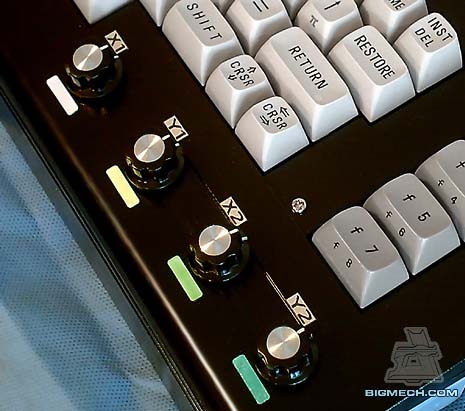
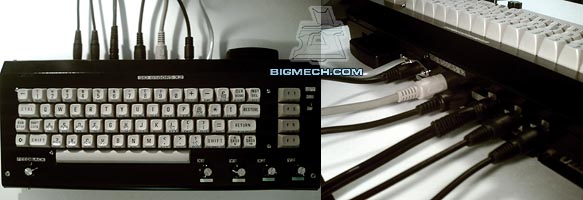
Doesn’t that just look fabulous? However, myself, I’m planning to paint upper part pink, and the lower, probably black. Ugly you may think, but I think it’ll look… fresh in some way.
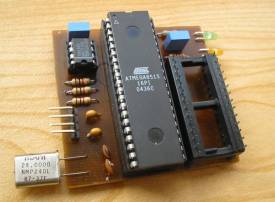
I also found this project, SwinSID which is a somewhat compatible SID clone, which I think sounds pretty good. A perfect combination would be to have one SID (To get the raw rough sound) and one SwinSID (To get some smooth wave forms) one a SID2SID. (A little cirucit board that lets you use two SIDs in one C64) I just wonder if SwinSID will work with SID2SID. I have yet to find out!
Anyway, being exposed to both these cool C64 mods within a matter of days, I have finally decided to get Prophet64.
Stay tuned for my report about it later on!
![You suck at protoshop. No, you [i]really[/i] oo.](http://blog.gg8.se/images/you-suck-at-photoshop-you-really-do-your-awful.png)





